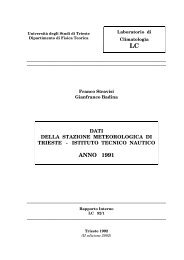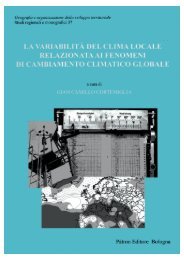Il livello del mare a Trieste: piani di riferimento e statistiche, 112, (05 ...
Il livello del mare a Trieste: piani di riferimento e statistiche, 112, (05 ...
Il livello del mare a Trieste: piani di riferimento e statistiche, 112, (05 ...
Create successful ePaper yourself
Turn your PDF publications into a flip-book with our unique Google optimized e-Paper software.
6<br />
L’istogramma dei valori orari è rappresentato nella fig. 3; l’elevazione me<strong>di</strong>a è<br />
<strong>di</strong> −6.5 cm sul piano P0, pari a 18.0 cm sullo zero Müller. Sono in<strong>di</strong>cati i principali<br />
quantili.<br />
Calcolo dei tempi <strong>di</strong> ritorno.<br />
Le definizioni sono le seguenti:<br />
[xi , i = 1, N] xi+1 ≥ xi N = 578,568 livelli orari in or<strong>di</strong>ne crescente,<br />
n(x) numero d’or<strong>di</strong>ne <strong>del</strong>l’ultimo dato ≤ x ,<br />
p(x) = n(x) / (N + 1) probabilità cumulata,<br />
s(x) = 1 − p(x) probabilità <strong>di</strong> superamento,<br />
T(x) = 1 / s(x) = (N + 1)/(N + 1 − n(x)) tempo <strong>di</strong> ritorno per un <strong>livello</strong> > x .<br />
I tempi <strong>di</strong> ritorno T sono espressi in unità uguali all’intervallo <strong>di</strong> campionamento<br />
dei dati. I tempi <strong>di</strong> ritorno calcolati in base al campione dei livelli orari <strong>del</strong> <strong>mare</strong><br />
a <strong>Trieste</strong> sono rappresentati nella fig. 4 e riportati nella tab. 3. Notiamo che<br />
solamente 5 valori orari in 65 anni hanno superato i 130 cm, e che i due valori<br />
massimi (148 e 193 cm) appaiono alquanto “anomali”; le stime riportate<br />
in<strong>di</strong>cherebbero quin<strong>di</strong> un limite inferiore per i corrispondenti tempi <strong>di</strong> ritorno.<br />
densità <strong>di</strong> occorrenza<br />
elevazione su P0<br />
/cm<br />
tempo <strong>di</strong> ritorno<br />
/anni<br />
100 110 120 130 140 150 160 170 180 190 200<br />
0.58 1.5 3.5 14 >28 >34 >42 >49 >56 >64 >70<br />
Tab. 3.- Tempo <strong>di</strong> ritorno per livelli orari superiori alla soglia in<strong>di</strong>cata. Dati 1939-2004.<br />
0.016<br />
0.014<br />
0.012<br />
0.010<br />
0.008<br />
0.006<br />
0.004<br />
0.002<br />
0.000<br />
-123 193<br />
-125 -100 -75 -50 -25 0 25 50 75 100 125 150 175 200<br />
<strong>livello</strong> /cm<br />
me<strong>di</strong>a: -6.4 cm<br />
quantili<br />
1%: -77 cm<br />
5%: -59 cm<br />
25%: -28 cm<br />
50%: - 6 cm<br />
75%: 15 cm<br />
95%: 41 cm<br />
99%: 59 cm<br />
Fig. 3.- Istogramma dei dati orari <strong>di</strong> <strong>livello</strong> 1939-2004 (<strong>riferimento</strong>: P0).





